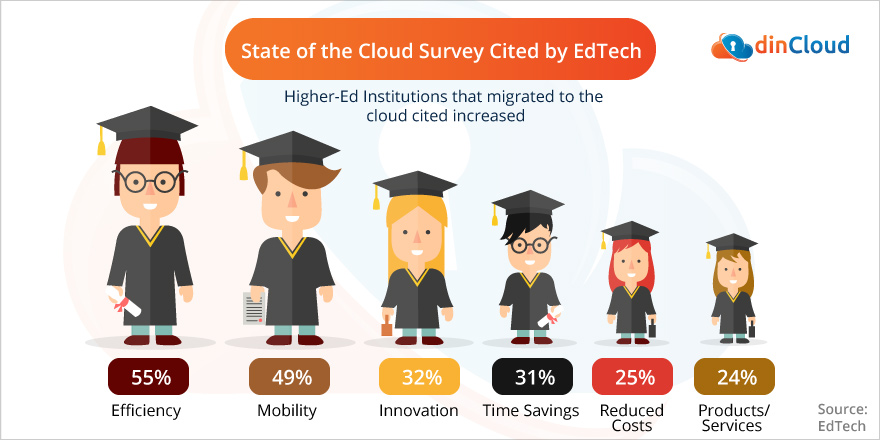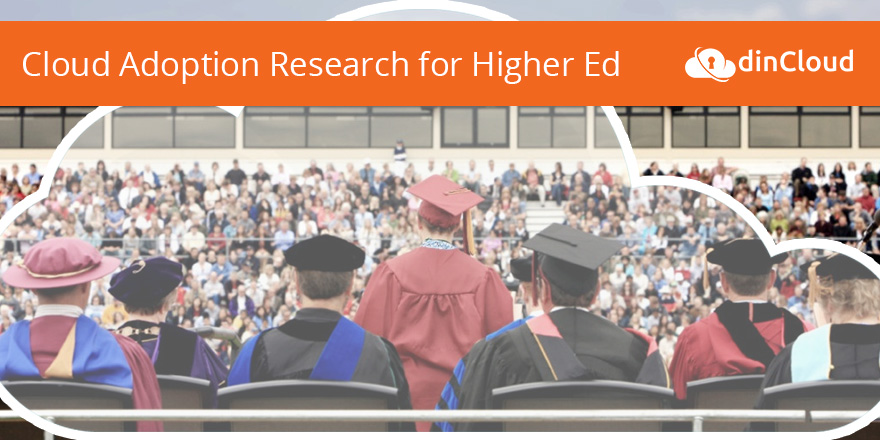CIO’s and their IT departments at Higher Education Institutions are facing many interesting challenges nowadays, and migrating to the cloud is just one of them. Technology is playing an increasing role for institutions to differentiate amongst direct competitors and also an onslaught of new entrants (Lynda, EdX, etc.) that are disrupting the way learning takes place.
Leadership at Higher Education institutions are looking for a better and more cost-effective way to implement their IT services, without the crushing cost of maintenance and upgrades, and to realize the full potential of their data to make better strategic decisions about the future.
Key Insights from New Research on Higher Ed
According to a recent study mentioned by EdTech Magazine, Higher-Ed Institutions that migrated to the cloud cited increased efficiency (55%), mobility (49%), innovation (32%), time savings (31%), reduced costs (25%), and the ability to roll out new products/services (24%). These benefits are the most common and point to the adoption of cloud based services.

In another survey cited by EdTech Magazine, 39% of applications at higher ed institutions are cloud based, but by 2021 that number could rise to 62% and 81% of Higher-Ed leaders indicated that they will increase their cloud spending in 2017. The question is, where and how are they spending this money? Below are a few examples.
While many universities and colleges are undergoing cloud migration for the cost saving benefits, they are also using the cloud as a way to improve the way students learn and study.
Let’s take a look at some of the ways students are seeing the impact of cloud computing:
- On-demand virtual workstations
- On-demand virtual networks and servers
- Access to labs on campus, and off
With more emphasis on technology in the classroom today than ever before, modernization is a big objective for education institutions.
When reading Deloitte’s Digital Education survey results, it was clear there is a Digital Transformation impacting the way students learn and the way teachers conduct lessons.
We found a couple things interesting:
- 81% of non-tenured teachers believe in the positive impact on learning from Edtech.
- However, nearly half feel their institution is “behind the curve” when it comes to technology adoption and implementation.
A new report from DJS research points in the same direction as well. According to the study, one-third of the students are of the opinion that their universities digital strategy is so poor that it is negatively impacting their overall impression of the institution. 7 in 10 respondents say their school needs to update their technology and 45% said they would be more likely to recommend their university to a peer if the digital experience improved.

Cloud for Higher Ed
Cloud computing as a technology platform is proving to be beneficial to countless education institutions across the US. Cloud services offer many benefits to education institutions including:
- Cost savings
- Fully managed maintenance and upgrades
- Scalability
Educational institutions are in the business of preparing students for the next stage of their life. In order to see how cloud services may help your institution, we recommend some additional articles and links:
Future of The Education Industry
Growing Trends in Digital Education Technology
What New Research Tells Us about Digital Strategy in Higher Ed


